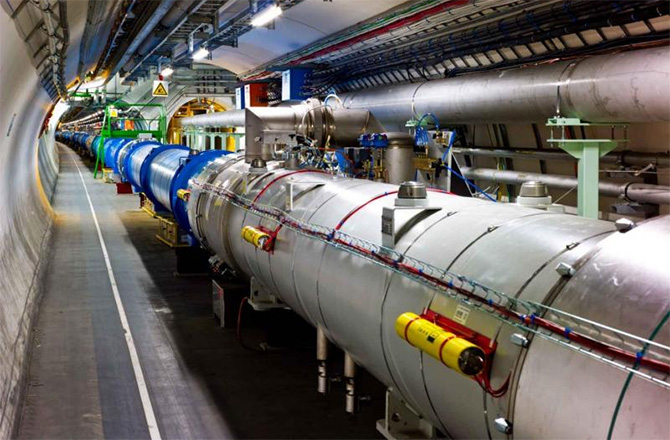LHC Ready to Hunt Down Mystery Dark Matter Particles

An upgraded, more powerful Large Hadron Collider, slated to begin returning to service next month, should open the door to new realms of physics, including possibly a glimpse of so-called "dark matter" particles, which, along with an equally mysterious dark energy force, dominates the universe.
Dark matter is so named because it does not emit or absorb light -- or any other electromagnetic radiation. Its presence is inferred by how its gravity impacts stars, galaxies, dust and other visible matter.
VIDEO: What is the Large Hadron Collider?
Scientists calculate that ordinary, visible matter accounts for about 5 percent of the universe. The rest is dark matter and a repulsive force called dark energy, which is accelerating the universe's expansion. [Dark Matter Search in Images]
"What we know about dark matter is that it exists, and then very little after that," physicist Michael Williams, with the Massachusetts Institute of Technology, told Discovery News.
"It would be nice if we could start to understand what dark matter is and how it affects the galaxy and the evolution of the universe, but just opening the door in particle physics to whatever is on the other side ... would be stepping into the unknown, which is exciting," he said.
A promising doorway into the new frontier is located at Europe's CERN particle physics laboratory near Geneva, home to the Large Hadron Collider, or LHC.
Get the Space.com Newsletter
Breaking space news, the latest updates on rocket launches, skywatching events and more!
NEWS: LHC Revs-Up for Most Powerful Particle Collisions Ever
In 2012, researchers using the world's most powerful atom smasher discovered a new subatomic particle, the Higgs boson, which is believed to give matter its mass. The work led to the 2013 Nobel Prize in Physics for two scientists who theorized the particle's existence.
After a two-year upgrade to more than double its power, the LHC may now provide proof of other versions of the Higgs boson, as well as hypothetical subatomic partners of quarks, leptons and other members of physic's standard family.
It is the lightest of these ghost particles that could match the footprints of dark matter, scientists said at the American Association for the Advancement of Science meeting in San Jose over the weekend.
"It's unclear what it is. It could be the supersymmetry partner of the photon -- the photino -- or of the graviton -- the gravitino," said Beate Heinemann, physics professor at the University of California at Berkeley.
NEWS: LHC's 'Heart' Starts Pumping Protons Before Restart
Only the lightest particles would be stable enough to exist since the creation of the universe 13.8 billion years ago, she added, and they would have to electrically neutral.
Depending on how much energy it takes to produce the particles and if they can be detected, scientists could have a dark matter candidate before the end of the year.
"We don't know what the mass is, so it could take the next year -- or 10 years after that," Heinemann said.
The LHC experiments also could provide search tips for scientists fishing for galactic dark matter particles that pass through Earth.
This article was provided by Discovery News.
Join our Space Forums to keep talking space on the latest missions, night sky and more! And if you have a news tip, correction or comment, let us know at: community@space.com.

Irene Klotz is a founding member and long-time contributor to Space.com. She concurrently spent 25 years as a wire service reporter and freelance writer, specializing in space exploration, planetary science, astronomy and the search for life beyond Earth. A graduate of Northwestern University, Irene currently serves as Space Editor for Aviation Week & Space Technology.










